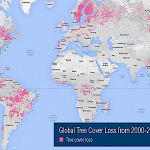
By Crystal Davis and Dave Thau
By the time we find out about deforestation, it’s usually too late to take action.
Scientists have been studying forests for centuries, chronicling the vital importance of these ecosystems for human society. But most of us still lack timely and reliable information about where, when and why forests are disappearing.
This will change with the launch of Global Forest Watch (GFW), an online forest monitoring system created by the World Resources Institute (WRI) and more than 40 partners. Global Forest Watch uses cutting-edge technologies to map the world’s forests with satellite imagery, detect changes in tree cover in near-real-time and make this information freely available to anyone with internet access.
With GFW, everyone from business executives to policymakers to indigenous groups can find out what’s happening in forests around the world—and use this information to take action. Now that we have the ability to peer into forests around the globe, a number of telling stories are beginning to emerge:
1. Global Tree Cover Loss Far Exceeds Tree Cover Gain
Data from the University of Maryland and Google shows that the world lost 2.3 million square kilometers of tree cover between 2000 and 2012—the equivalent of losing 50 soccer fields’ worth of forests every minute of every day for the past 13 years. By contrast, only 0.8 million square kilometers have regrown, been planted, or restored during the same period.

Leave a Reply
You must be logged in to post a comment.